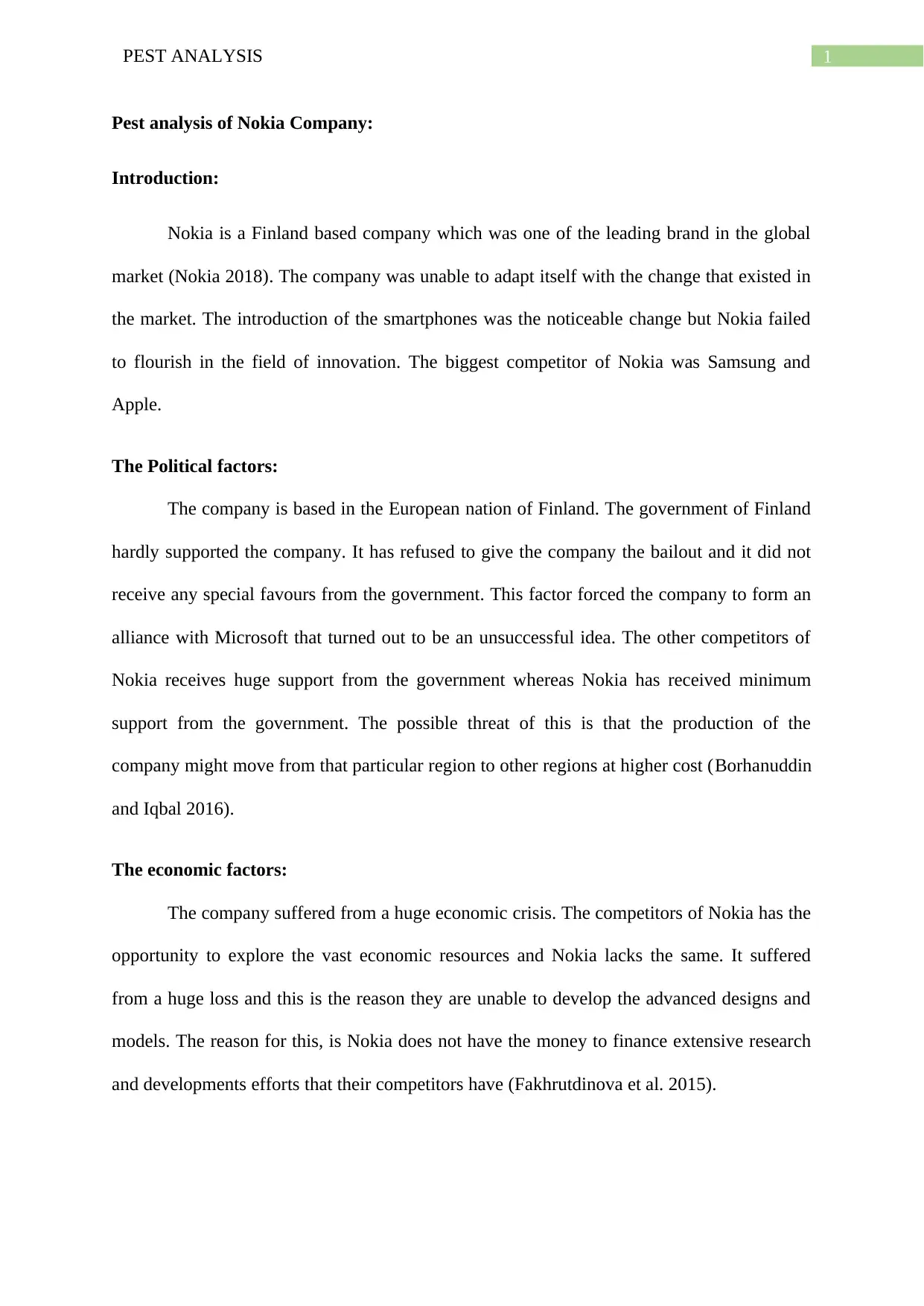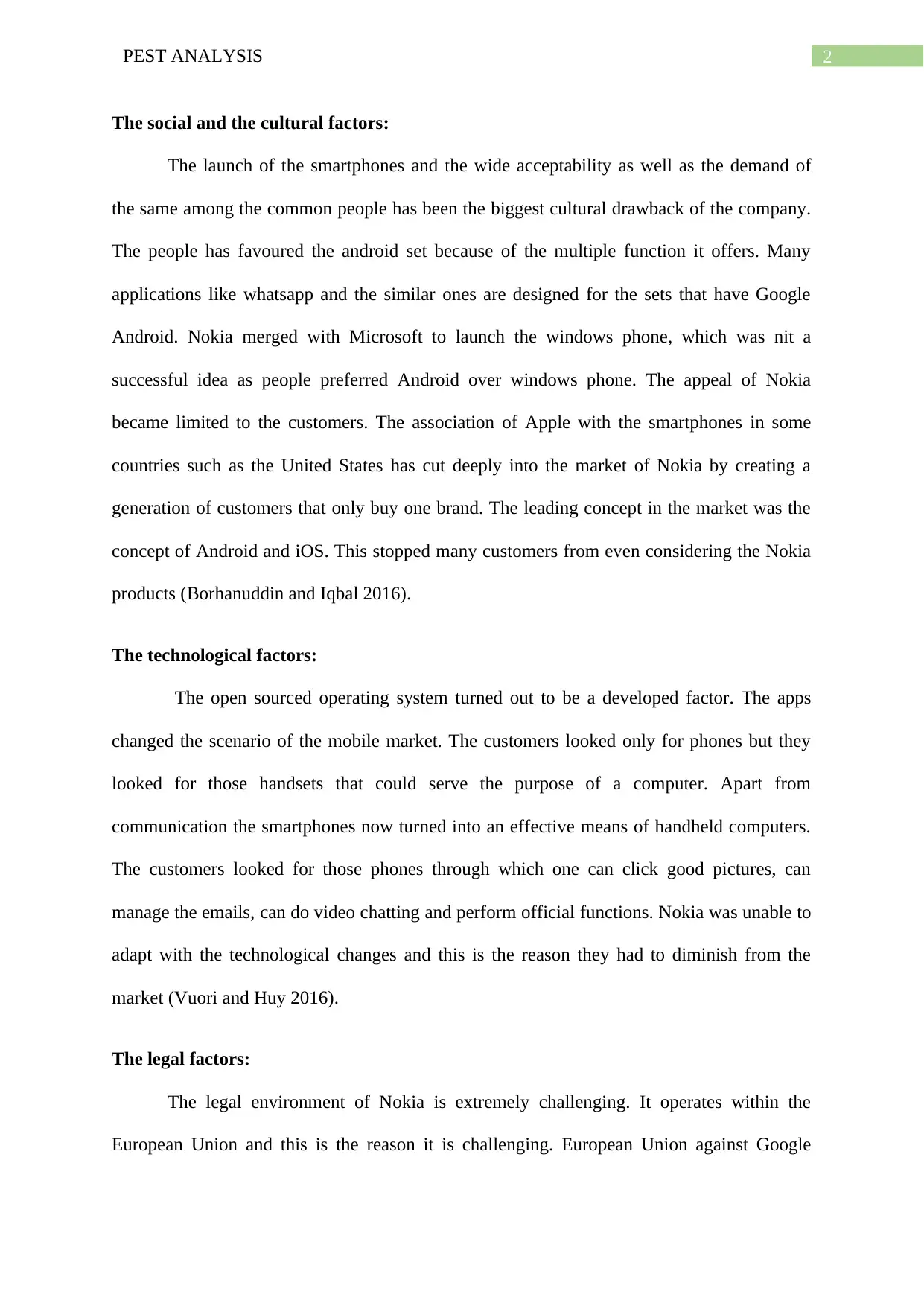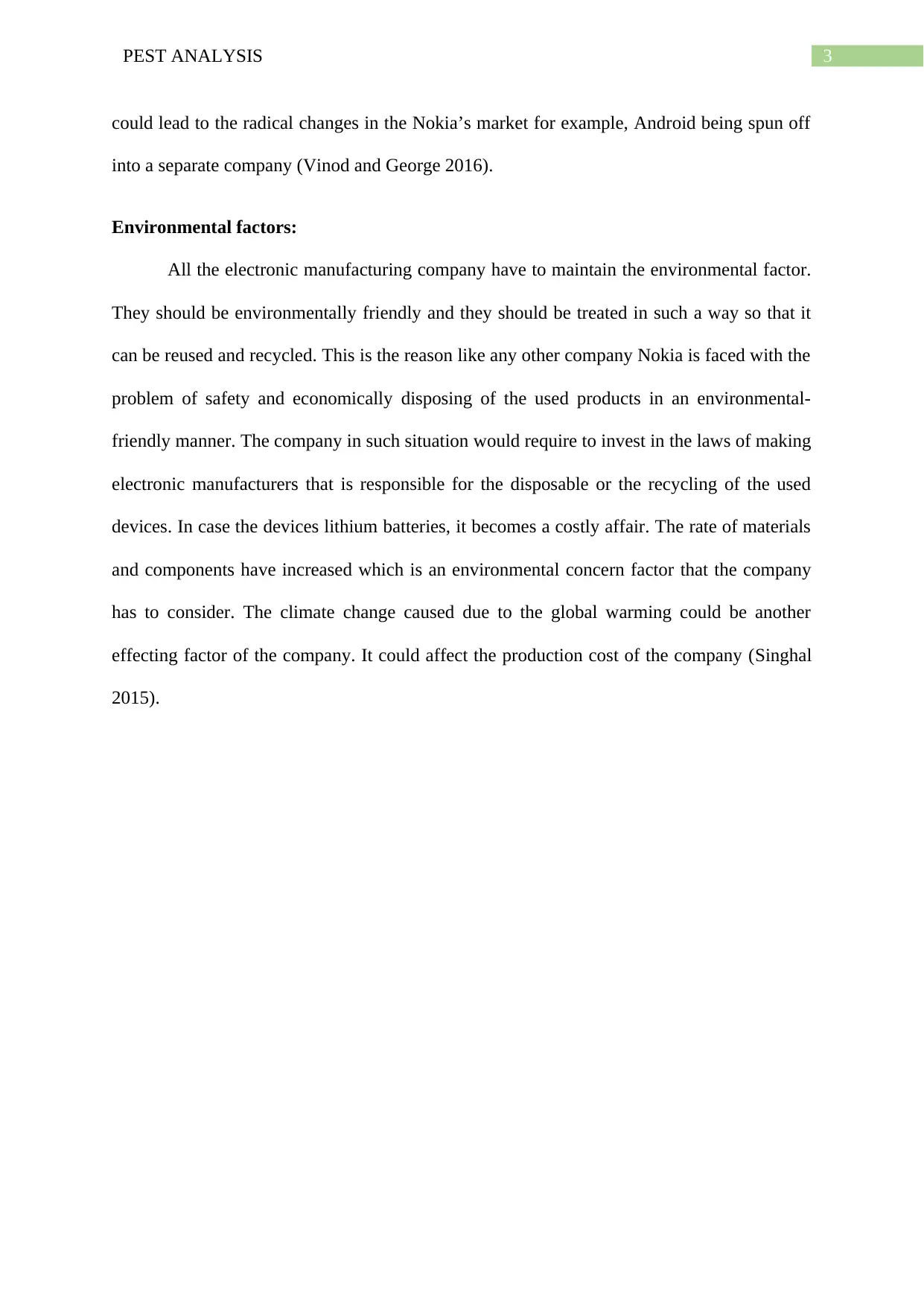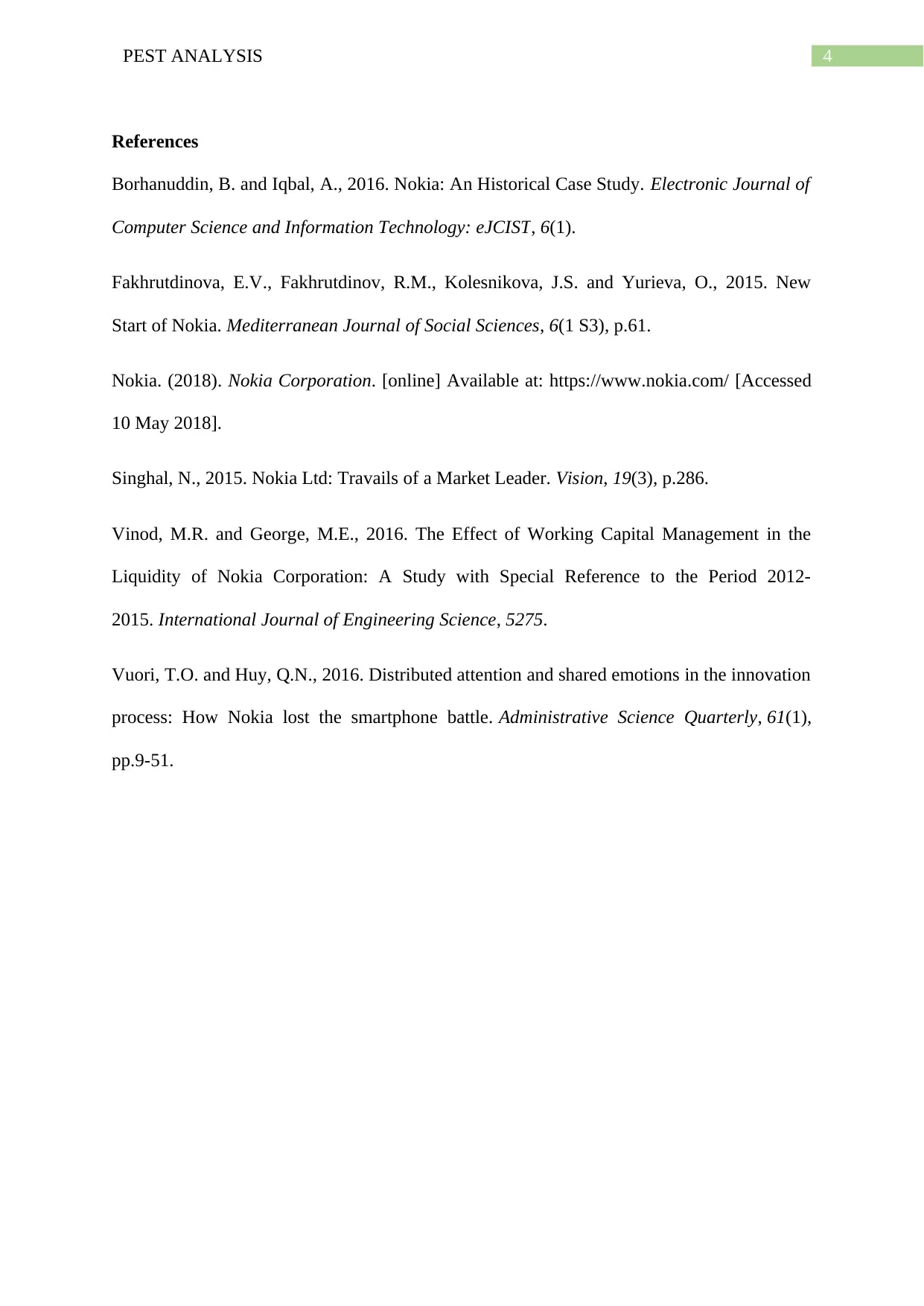Comprehensive PEST Analysis: Nokia's Strategic Missteps & Future
VerifiedAdded on 2021/05/31
|5
|1016
|370
Case Study
AI Summary
This case study provides a PEST analysis of Nokia, a Finland-based company that was once a global market leader but failed to adapt to changing market dynamics, particularly the rise of smartphones. The analysis covers political factors, highlighting the lack of government support in Finland compared to competitors; economic factors, including Nokia's financial struggles that hindered research and development; social and cultural factors, such as the widespread adoption of Android and iOS; technological factors, with Nokia's inability to adapt to open-source operating systems and app-driven functionalities; legal factors, focusing on the challenging regulatory environment within the European Union; and environmental factors, including the costs associated with environmentally friendly disposal and recycling of electronic devices. The study references various sources to support its analysis of Nokia's strategic missteps and market challenges.

Running head: PEST ANALYSIS
Pest analysis
Name of the student
Name of the university
Author note
Pest analysis
Name of the student
Name of the university
Author note
Paraphrase This Document
Need a fresh take? Get an instant paraphrase of this document with our AI Paraphraser

1PEST ANALYSIS
Pest analysis of Nokia Company:
Introduction:
Nokia is a Finland based company which was one of the leading brand in the global
market (Nokia 2018). The company was unable to adapt itself with the change that existed in
the market. The introduction of the smartphones was the noticeable change but Nokia failed
to flourish in the field of innovation. The biggest competitor of Nokia was Samsung and
Apple.
The Political factors:
The company is based in the European nation of Finland. The government of Finland
hardly supported the company. It has refused to give the company the bailout and it did not
receive any special favours from the government. This factor forced the company to form an
alliance with Microsoft that turned out to be an unsuccessful idea. The other competitors of
Nokia receives huge support from the government whereas Nokia has received minimum
support from the government. The possible threat of this is that the production of the
company might move from that particular region to other regions at higher cost (Borhanuddin
and Iqbal 2016).
The economic factors:
The company suffered from a huge economic crisis. The competitors of Nokia has the
opportunity to explore the vast economic resources and Nokia lacks the same. It suffered
from a huge loss and this is the reason they are unable to develop the advanced designs and
models. The reason for this, is Nokia does not have the money to finance extensive research
and developments efforts that their competitors have (Fakhrutdinova et al. 2015).
Pest analysis of Nokia Company:
Introduction:
Nokia is a Finland based company which was one of the leading brand in the global
market (Nokia 2018). The company was unable to adapt itself with the change that existed in
the market. The introduction of the smartphones was the noticeable change but Nokia failed
to flourish in the field of innovation. The biggest competitor of Nokia was Samsung and
Apple.
The Political factors:
The company is based in the European nation of Finland. The government of Finland
hardly supported the company. It has refused to give the company the bailout and it did not
receive any special favours from the government. This factor forced the company to form an
alliance with Microsoft that turned out to be an unsuccessful idea. The other competitors of
Nokia receives huge support from the government whereas Nokia has received minimum
support from the government. The possible threat of this is that the production of the
company might move from that particular region to other regions at higher cost (Borhanuddin
and Iqbal 2016).
The economic factors:
The company suffered from a huge economic crisis. The competitors of Nokia has the
opportunity to explore the vast economic resources and Nokia lacks the same. It suffered
from a huge loss and this is the reason they are unable to develop the advanced designs and
models. The reason for this, is Nokia does not have the money to finance extensive research
and developments efforts that their competitors have (Fakhrutdinova et al. 2015).

2PEST ANALYSIS
The social and the cultural factors:
The launch of the smartphones and the wide acceptability as well as the demand of
the same among the common people has been the biggest cultural drawback of the company.
The people has favoured the android set because of the multiple function it offers. Many
applications like whatsapp and the similar ones are designed for the sets that have Google
Android. Nokia merged with Microsoft to launch the windows phone, which was nit a
successful idea as people preferred Android over windows phone. The appeal of Nokia
became limited to the customers. The association of Apple with the smartphones in some
countries such as the United States has cut deeply into the market of Nokia by creating a
generation of customers that only buy one brand. The leading concept in the market was the
concept of Android and iOS. This stopped many customers from even considering the Nokia
products (Borhanuddin and Iqbal 2016).
The technological factors:
The open sourced operating system turned out to be a developed factor. The apps
changed the scenario of the mobile market. The customers looked only for phones but they
looked for those handsets that could serve the purpose of a computer. Apart from
communication the smartphones now turned into an effective means of handheld computers.
The customers looked for those phones through which one can click good pictures, can
manage the emails, can do video chatting and perform official functions. Nokia was unable to
adapt with the technological changes and this is the reason they had to diminish from the
market (Vuori and Huy 2016).
The legal factors:
The legal environment of Nokia is extremely challenging. It operates within the
European Union and this is the reason it is challenging. European Union against Google
The social and the cultural factors:
The launch of the smartphones and the wide acceptability as well as the demand of
the same among the common people has been the biggest cultural drawback of the company.
The people has favoured the android set because of the multiple function it offers. Many
applications like whatsapp and the similar ones are designed for the sets that have Google
Android. Nokia merged with Microsoft to launch the windows phone, which was nit a
successful idea as people preferred Android over windows phone. The appeal of Nokia
became limited to the customers. The association of Apple with the smartphones in some
countries such as the United States has cut deeply into the market of Nokia by creating a
generation of customers that only buy one brand. The leading concept in the market was the
concept of Android and iOS. This stopped many customers from even considering the Nokia
products (Borhanuddin and Iqbal 2016).
The technological factors:
The open sourced operating system turned out to be a developed factor. The apps
changed the scenario of the mobile market. The customers looked only for phones but they
looked for those handsets that could serve the purpose of a computer. Apart from
communication the smartphones now turned into an effective means of handheld computers.
The customers looked for those phones through which one can click good pictures, can
manage the emails, can do video chatting and perform official functions. Nokia was unable to
adapt with the technological changes and this is the reason they had to diminish from the
market (Vuori and Huy 2016).
The legal factors:
The legal environment of Nokia is extremely challenging. It operates within the
European Union and this is the reason it is challenging. European Union against Google
⊘ This is a preview!⊘
Do you want full access?
Subscribe today to unlock all pages.

Trusted by 1+ million students worldwide

3PEST ANALYSIS
could lead to the radical changes in the Nokia’s market for example, Android being spun off
into a separate company (Vinod and George 2016).
Environmental factors:
All the electronic manufacturing company have to maintain the environmental factor.
They should be environmentally friendly and they should be treated in such a way so that it
can be reused and recycled. This is the reason like any other company Nokia is faced with the
problem of safety and economically disposing of the used products in an environmental-
friendly manner. The company in such situation would require to invest in the laws of making
electronic manufacturers that is responsible for the disposable or the recycling of the used
devices. In case the devices lithium batteries, it becomes a costly affair. The rate of materials
and components have increased which is an environmental concern factor that the company
has to consider. The climate change caused due to the global warming could be another
effecting factor of the company. It could affect the production cost of the company (Singhal
2015).
could lead to the radical changes in the Nokia’s market for example, Android being spun off
into a separate company (Vinod and George 2016).
Environmental factors:
All the electronic manufacturing company have to maintain the environmental factor.
They should be environmentally friendly and they should be treated in such a way so that it
can be reused and recycled. This is the reason like any other company Nokia is faced with the
problem of safety and economically disposing of the used products in an environmental-
friendly manner. The company in such situation would require to invest in the laws of making
electronic manufacturers that is responsible for the disposable or the recycling of the used
devices. In case the devices lithium batteries, it becomes a costly affair. The rate of materials
and components have increased which is an environmental concern factor that the company
has to consider. The climate change caused due to the global warming could be another
effecting factor of the company. It could affect the production cost of the company (Singhal
2015).
Paraphrase This Document
Need a fresh take? Get an instant paraphrase of this document with our AI Paraphraser

4PEST ANALYSIS
References
Borhanuddin, B. and Iqbal, A., 2016. Nokia: An Historical Case Study. Electronic Journal of
Computer Science and Information Technology: eJCIST, 6(1).
Fakhrutdinova, E.V., Fakhrutdinov, R.M., Kolesnikova, J.S. and Yurieva, O., 2015. New
Start of Nokia. Mediterranean Journal of Social Sciences, 6(1 S3), p.61.
Nokia. (2018). Nokia Corporation. [online] Available at: https://www.nokia.com/ [Accessed
10 May 2018].
Singhal, N., 2015. Nokia Ltd: Travails of a Market Leader. Vision, 19(3), p.286.
Vinod, M.R. and George, M.E., 2016. The Effect of Working Capital Management in the
Liquidity of Nokia Corporation: A Study with Special Reference to the Period 2012-
2015. International Journal of Engineering Science, 5275.
Vuori, T.O. and Huy, Q.N., 2016. Distributed attention and shared emotions in the innovation
process: How Nokia lost the smartphone battle. Administrative Science Quarterly, 61(1),
pp.9-51.
References
Borhanuddin, B. and Iqbal, A., 2016. Nokia: An Historical Case Study. Electronic Journal of
Computer Science and Information Technology: eJCIST, 6(1).
Fakhrutdinova, E.V., Fakhrutdinov, R.M., Kolesnikova, J.S. and Yurieva, O., 2015. New
Start of Nokia. Mediterranean Journal of Social Sciences, 6(1 S3), p.61.
Nokia. (2018). Nokia Corporation. [online] Available at: https://www.nokia.com/ [Accessed
10 May 2018].
Singhal, N., 2015. Nokia Ltd: Travails of a Market Leader. Vision, 19(3), p.286.
Vinod, M.R. and George, M.E., 2016. The Effect of Working Capital Management in the
Liquidity of Nokia Corporation: A Study with Special Reference to the Period 2012-
2015. International Journal of Engineering Science, 5275.
Vuori, T.O. and Huy, Q.N., 2016. Distributed attention and shared emotions in the innovation
process: How Nokia lost the smartphone battle. Administrative Science Quarterly, 61(1),
pp.9-51.
1 out of 5
Related Documents
Your All-in-One AI-Powered Toolkit for Academic Success.
+13062052269
info@desklib.com
Available 24*7 on WhatsApp / Email
![[object Object]](/_next/static/media/star-bottom.7253800d.svg)
Unlock your academic potential
Copyright © 2020–2025 A2Z Services. All Rights Reserved. Developed and managed by ZUCOL.





